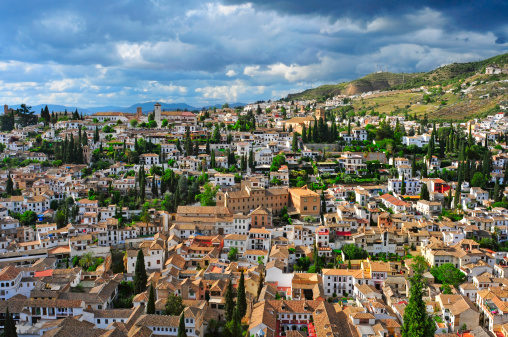
Above Granada Sits The Alhambra Palace
 Perched above Granada sits The Alhambra Palace - the world's last and most famous Moorish palace. This majestic landmark is strategically placed on the hill al-Sabika and overlooks the entire city of Granada and the valley La Vega.
Perched above Granada sits The Alhambra Palace - the world's last and most famous Moorish palace. This majestic landmark is strategically placed on the hill al-Sabika and overlooks the entire city of Granada and the valley La Vega.
History of Alhambra (Arabic for the read sea) dates all the way back to the ninth century, when civil wars forced military to take refuge in the West. They hid in what was then called the Alcazaba, a fortress that later became the palace it is today.
Repairs and expansion began on the fortress and due to its location it was used as a military base for many centuries. Upon arrival of the Nasrid Dynasty to the region in the 1200s, King Mohammed ben Al-Hamar moved into the Alhambra and continued expansion on his new family estate. Mohammed contributed to the development of the watch tower, the keep, and many other chambers of the palace. His successors followed suit and carried out construction of the public baths and the mosque.
Mohammed V and Yusuf I were responsible for most the most famous construction that visitors today are most familiar with. The justice gate, the patio of lions, and the hall of boats are just of few of the additions contributed under these kings. Few things remain of any Moorish kings after the fifteenth century.
When Catholic Monarchs took over the region, King Charles V demanded demolition of parts of the palace in order to build his own wing. This reconstruction included new queen's dressing room and king's separate chambers. Catholics were driven out of the region shortly after and left Alhambra completely abandoned for well into the 19th century.
The French dominated the area for a short time in the early 1800s, and during this time blew up part of the palace. After their short reign, restoration construction broke ground to conserve and celebrate the history of this magnificent landmark. Today it is one of Spain's most popular attractions, with beautiful architecture and gardens for visitors to enjoy!
Alhambra is not just one large palace it is made up of many buildings and chambers spread out over 2,000 feet! Its massive size makes it very difficult to get through in one day. It is advised that visitors map out ahead of time which elements of the palace they wish to see most, coming up with a game plan for the day of the visit! Below is a description of different parts of Alhambra that will help you decide which parts of Alhambra appeal to you most!
The Alcazaba, this is the oldest building on property. The original function of the Alcazaba was as a fortress in the ninth century; a refuge for Muslims.
The Nasrid Palace these are a series of smaller palaces with ornate construction, and were home to the last of the Nasrid rulers of the thirteenth century. They consist of El Mexuar, The Comares or Yusuf I Palace, and The Palace of the Lions, or of Mohammed V.
The Carlos V Palace Upon his visit to Granada, Emperor Carlos V fell in love and decided to make it his residence. He demanded he live in Alhambra, and ordered construction of his own palace on property. His palace's design is very heavily inspired by Arab architecture, and proves the king's awareness of the beauty of the Arab palaces.
Rauda this wing is the Royal Cemetery. The gardens of Rauda are the final resting place for many of the Granadine rulers. Located right outside the Nasrid palaces, visitors can easily navigate their way through the gardens to get the most out of the property's facilities.
Generalife Gardens-The picturesque gardens of this incredible property prove the icing on the cake of your Alhambra tour. At the front of the gardens is an amphitheater, which hosts the areas annual Music and Dance Festival.
A trip to the Alhambra palace is essential to your next Spain vacation! Don't miss the chance to see the world's oldest Moorish palace, as Granada's biggest landmark!
